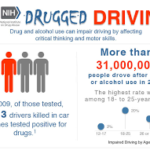 SAM, Sensible Approaches to Marijuana, is an organization dedicated to fighting the commercialization of marijuana and its expanded use. Their original charter is now expanding beyond marijuana as they have established the Foundation for Drug Policy Solutions.
SAM, Sensible Approaches to Marijuana, is an organization dedicated to fighting the commercialization of marijuana and its expanded use. Their original charter is now expanding beyond marijuana as they have established the Foundation for Drug Policy Solutions.
They offer Toolkits to help people address specific problems caused by legalizing and commercializing psychoactive drugs. One of the Toolkits is entitled, “Has marijuana legalization made the roadways less safe? Yes”.
Recognizing DUID Victim Voices’ expertise, recently SAM asked us to update their Toolkit shown in the above link.
The primary revisions to SAM’s previous Toolkit were:
- expanding the scope from marijuana-impaired driving to cover all facets of drugged driving, especially polydrug impairment, and
- updating information to show results of the latest research.
Perhaps the most important correction to SAM’s prior Toolkit was to amend the widely quoted but false notion that marijuana use doubles crash risk. The increased risk is actually much greater than that.
The idea that marijuana use “doubles the risk” comes from a plethora of mostly well-respected studies and especially meta-analyses that compare crash prevalence in two pools of subjects:
- sober drivers, and
- drivers who test positive for the presence of marijuana’s tetrahydrocannabinol, a.k.a THC.
Results of studies vary widely from showing drivers positive for THC are 13 times more likely to be in crashes, to showing drivers positive for THC are five times less likely to be in crashes.
Because of the wide variance in results, most analysts pay little heed to select studies, relying instead on meta-analyses that pool the results of multiple studies in statistically acceptable ways. The earliest meta-analyses showed a doubling of risk for THC-positive drivers but recent analyses have resulted in a lower number.
Unfortunately, THC presence doesn’t mean very much as discussed in numerous postings including THC per se laws don’t work and Another badly flawed study.
As we’ve pointed out before, THC and alcohol don’t impair blood, they impair the brain. And because THC is not water soluble, unlike alcohol, one cannot use blood tests to determine THC content in the brain.
Like alcohol, impairment is a function of, among other things, the dose of alcohol or THC that was taken. A low dose of either drug causes so little impairment there is little danger to the public. A high dose of either drug impairs users, regardless of how experienced the user is with the drug.
With alcohol, one can get a good idea of the dose recently consumed by a blood or breath test. That is impossible for THC.
Chronic users can maintain a chronic low level of THC in their blood even though the THC has migrated from the brain to other fatty tissues and the THC-caused impairment has subsided.
When chronic users are included in studies of crash risk versus THC presence, they will be included in the pools of subjects that have THC presence, even though they may not be impaired. This will cause the estimate of THC associated crash risk to be much lower than it would be if there were a way to only study drivers who were actually THC impaired, not just THC positive.
As explained in the SAM Toolkit, there is now a way to determine crash risk based on THC impairment, not just THC presence.
This is done by using Colorado data showing crash risk for drivers proven to be impaired by court rulings. When we look at those numbers, we find that the crash risk of drivers proven to be impaired is about TEN TIMES that of sober drivers, but still only one-third of the crash risk of the average drunk driver who has a BAC of 0.16 gm/dL.
